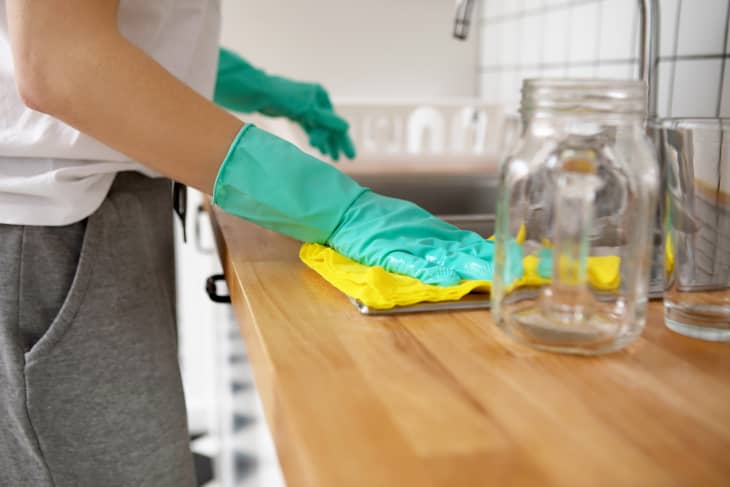3 Things You Need to Safely Deep-Clean Your Home — Along with Some Expert-Recommended Cleaning Solutions
Recently, I determined I would make my son’sbaseball pants, covered in months of dirt,completely whiteagain. I briefly researched and bought some powder claiming it would return everything to a fresh, white, original state. But I didn’t consider the risks and took exactly zero precautions before getting started.
For more content like this follow
I poured the recommended amount of the powder into a countertop tub full of warm water, and the solution started… smoking. Well, fuming is probably a more accurate description. I figured that was normal, and carried on, submerging the pants. Before I knew it, I was a little lightheaded from the fumes and developed a scratchy sore throat. When it hadn’t improved a few hours later, I called poison control, confused about why a “safe” product would produce this reaction. Though they assured me I would be fine, it was a wake-up call that even seemingly safe items used while cleaning your home might contain more toxins and harmful substances than we think.
下个星期,我又一次有不同的刺激uct, but this time equipped with gloves, a mask, an open window, and a washing machine with some distance between myself and the product. All around it was a much more successful and less fume-y experience.
I then set off to better understand the full range of items really needed for specific laundry projects and a whole house clean. These experts pointed me in the right direction for some must-have finds in the pursuit of a squeaky clean home, in a safe manner, down to the last hidden corner.
Getting started on your first big deep clean
If you are working against weeks, months (maybe even years) of dirt, grime, and buildup on multiple types of surfaces, Camila Machado ofCamila’s Cleaning Servicesays that you might need to use some serious deep cleaning products, ones that involve more chemicals than you’d use for a lighter “maintenance” clean.
“If you haven’t cleaned in weeks or months, in order to fully get rid of germs, you need to use the deep cleaning products first. Then to maintain in between deep cleans, the natural cleaning products are great for ongoing maintenance, meaning for the everyday clean,” she says.
But take caution to protect yourself against the impacts on your skin and lungs. To safely deep clean your home, use masks and gloves, and make sure the area is well-ventilated to create a barrier between yourself and more potent chemicals.
Here are some high-impact cleaning products she recommends:
- Clorox Clean-Up Cleaner + Bleachfor killing germs and bacteria and making surfaces whiter in the bathroom
- Formula 409 Multi-Surface Cleanerfor cleaning cabinets and removing fingerprints on walls
- Easy-offfor cleaning ovens, oven doors, and barbecue grills
- Soft ScruborBar Keepers Friendfor kitchen sinks and surfaces
- Murphy’s Oil SoaporLysolfor floors
Give windows a special treatment
While it might seem like you can just use any multi-purpose cleaner on windows, they call for specifically made glass cleaning products, such asWindex. Ken Fisk, director of technical services ofWindow Genie, a Neighborly company, reminds people not to forget to clean screens too as part of a deep clean. “If you remember to clean your windows and they are now sparkling and clear, the window pane’s worst enemy is a dirty screen,” says Fisk. “When it rains, rain passing through a dirty screen will transfer dirt and debris onto your glass, instantly making your windows dirty again. Cleaning screens is as simple as gently brushing the screen with a dry brush and then rinsing it with a hose.”
His secret weapon for a full window clean and surrounding areas like window tracks in a sliding door is an old toothbrush and two kitchen staples: baking soda and vinegar. He suggests removing loose debris with a vacuum and dislodging the rest with the toothbrush. Then, if necessary, sprinkle a light dusting of baking soda, along with a spritz of vinegar and water. Once you let it sit a bit, wipe up the solution and grime with a clean rag or paper towel. Ideally, if you usebaking soda and vinegar, you’ll want to act fast before they cancel each other out.
Finally, Fisk says not to forget the outside of your home during a deep clean, which needs a pressure washer to preventmold and mildewgrowth (these can lead to increased allergy symptoms).
Deep cleaning is a two-step process
While it might seem like you just need to wipe down dirty surfaces, it takes a bit more muscle than that. James Dudra, the founder ofTherapy Clean, says that “to achieve ‘deep cleaning,’ consumers need a combination of chemical and manual cleaning.”
“We need to leverage the efficiency of the chemical to break down soils — followed by a thorough scrubbing to remove the balance,” he adds. “This requires the consumer to first select the correct cleaner, and secondly pair it with a tool that can agitate and remove remaining grime.” He recommends surface-specific cleaners for the initial product, rather than an all-purpose cleaner, which will help with a deeper clean for that surface.
“Cleaning product companies will optimize the pH, solvent, and surfactant blend based on the type of contaminants being cleaned. For example, bathroom cleaners are typically low pH (acidic) to remove soap scum and lime. Whereas kitchen cleaners are high pH (alkaline) to dissolve fats, oils, and greases. And of course, all-purpose cleaners normally fall within the ‘neutral’ category to work on a variety of surfaces,” he explains. He recommends letting products dwell on the surface for longer than you’d think, up to 10 minutes for stains, for instance. Then you begin the “agitation” process by putting some muscle into it, and scrubbing.
安全预防措施,他还警告消费者没有t to mix chemicals, which can be not only dangerous but even fatal. Though I followed the directions in my original laundry experiment, it was a good reminder to be a bit more diligent in using cleaners in the future, for my lungs’ sake.

